When you think about comfort food, rice pudding often comes to mind, doesn't it? This creamy dessert has a rich history and can be tailored to suit your taste. You might start with the basic ingredients, but there's so much more to consider—like the subtle spices or textures you can add. What if I told you that a few simple tweaks could elevate your rice pudding into a truly unique dish? Let's explore the steps and possibilities that await you in this classic recipe.
Key Takeaways
- Combine 1/3 cup rinsed rice with 2 1/2 cups of milk and 1/4 cup sugar in a saucepan.
- Simmer the mixture for 20-25 minutes, stirring frequently until the rice is tender.
- Stir in a pinch of salt and 1/2-1 teaspoon of vanilla extract for enhanced flavor.
- Adjust sweetness to taste by adding more sugar or alternative sweeteners before serving.
- Serve warm or chilled, garnished with cinnamon, fruits, or nuts for added texture.
History
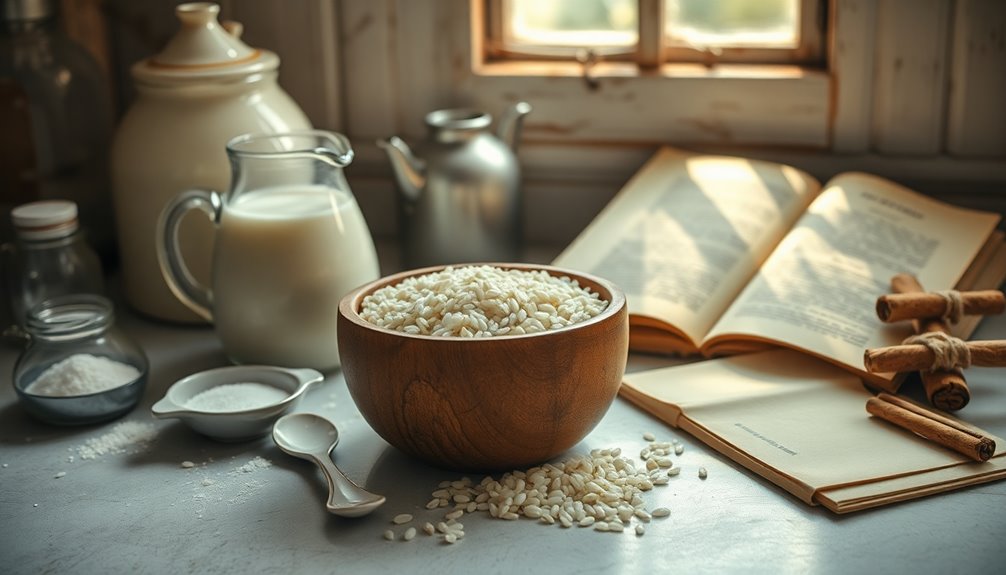
Rice pudding has a rich history that dates back to ancient civilizations, where it was often prepared as a nourishing dish combining rice, milk, and sweeteners.
Over time, this comforting dish evolved, becoming a favorite among medieval European aristocrats who added spices and sugar for a luxurious twist.
You may know it as "arroz con leche" in Spanish-speaking countries or "kheer" in Indian cuisine, showcasing its global appeal.
Traditionally, rice pudding was a staple during festive occasions, symbolizing prosperity and family unity.
Today, you can find countless rice pudding recipes that pay homage to its roots while incorporating modern flavors and ingredients, making it a timeless comfort food beloved around the world.
Recipe

Rice pudding is a classic dessert that brings warmth and comfort to any table. With its creamy texture and subtle sweetness, it's a favorite for both children and adults alike. This delightful dish isn't only easy to prepare but also allows for variations to suit your taste.
Whether enjoyed warm with a sprinkle of cinnamon or chilled with a dollop of whipped cream, rice pudding can be a versatile treat for any occasion.
To make a delicious rice pudding, you'll need a few simple ingredients that you may already have in your pantry. The cooking method is straightforward, making this recipe perfect for novice cooks or anyone looking for a quick and satisfying dessert.
Once you master the basic recipe, feel free to experiment with add-ins like fruits, nuts, or flavored extracts to create your own signature version.
Ingredients:
- 1/3 cup long or short grain white rice
- 2 1/2 cups whole or reduced-fat milk
- 1/4 cup granulated sugar
- Pinch of salt
- 1/4 cup raisins (optional)
- 1/4 teaspoon cinnamon (optional)
- 1/2-1 teaspoon vanilla extract (optional)
In a medium saucepan, combine the rice, milk, sugar, and a pinch of salt. Bring the mixture to a boil over medium-high heat, stirring occasionally to prevent sticking.
Once boiling, reduce the heat to a simmer and cook for 20-25 minutes, stirring frequently, until the rice is tender and the mixture has thickened. If desired, add the raisins and cinnamon during the last few minutes of cooking.
Remove from heat and stir in the vanilla extract for added flavor. Serve warm, cold, or at room temperature, and consider garnishing with whipped cream or a sprinkle of cinnamon.
For best results, ensure that you stir the pudding frequently to prevent the rice from sticking to the bottom of the saucepan. If you prefer a creamier texture, you can adjust the amount of milk used.
Additionally, feel free to experiment with other flavors by adding lemon zest, nutmeg, or even coconut milk for a tropical twist. Rice pudding can be stored in the refrigerator for a few days, making it a great make-ahead dessert.
Enjoy your homemade rice pudding!
Cooking Steps
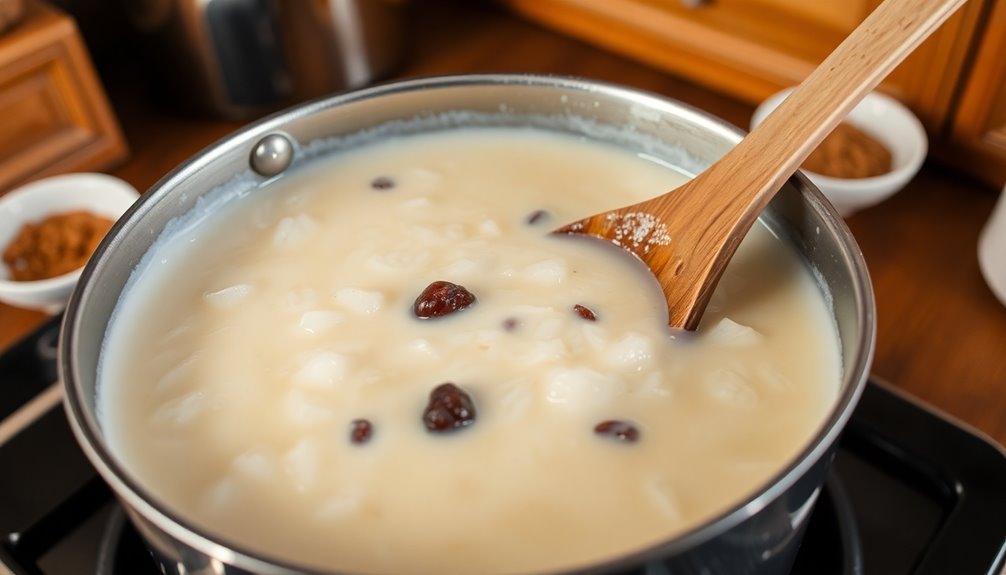
To make your rice pudding, you'll start by rinsing the rice thoroughly to get rid of excess starch.
Next, add the milk gradually and let the mixture simmer until it thickens.
Don't forget to stir in vanilla extract and sweetener to taste for that perfect flavor!
Step 1. Rinse the Rice Thoroughly
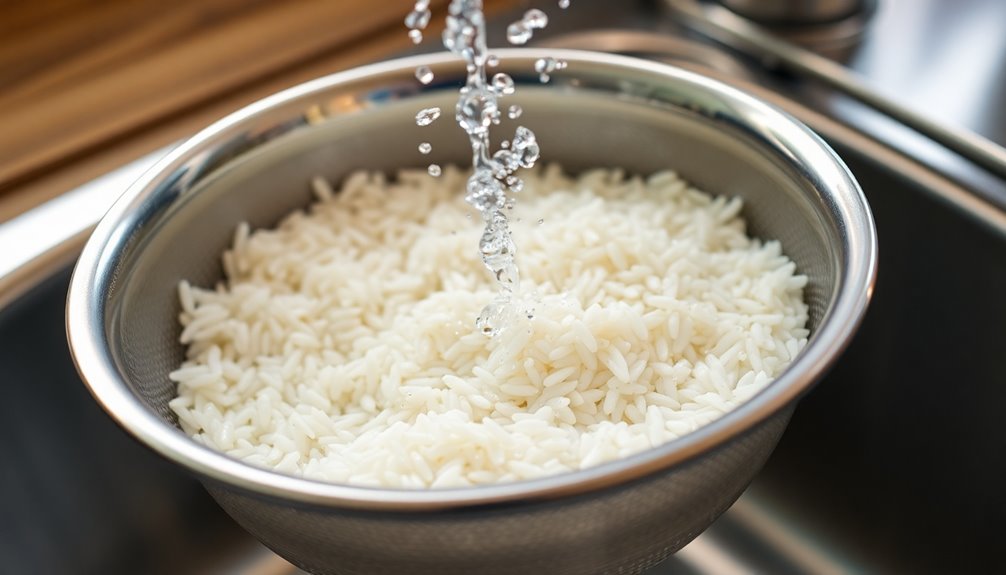
Before you dive into cooking, make sure to rinse the rice thoroughly, as this crucial step helps eliminate excess starch.
Place the rice in a fine-mesh strainer or bowl and run cold water over it. Agitate the rice gently with your hands, allowing the water to carry away the surface starch. Rinse for about 1-2 minutes, ensuring the water runs clear.
This process is essential to prevent your rice pudding from becoming too gummy or sticky during cooking. Properly rinsed rice contributes to a better texture, allowing the creamy milk mixture to envelop the grains more effectively.
Take your time with this step; it's worth it for that perfect rice pudding consistency you desire!
Step 2. Add Milk Gradually
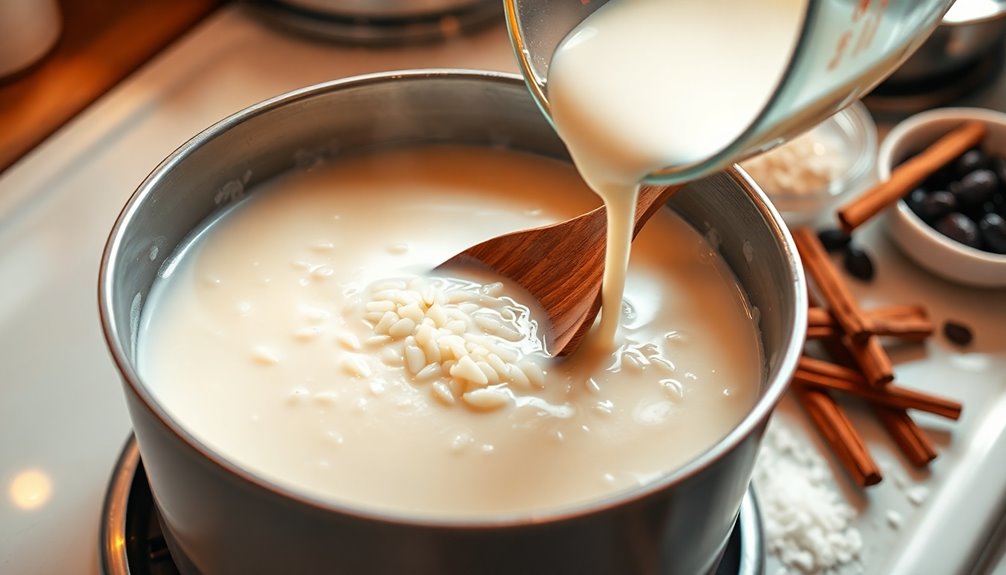
As you start cooking your rice pudding, combine the cooked rice with a small portion of milk to create a creamy base.
Once that's mixed, it's time to add the rest of the milk gradually. This step is crucial because it allows you to control the thickness of your pudding, preventing it from becoming too watery.
After each addition of milk, bring the mixture to a simmer, which helps the rice absorb the liquid and thickens the pudding effectively.
Remember to stir frequently while adding milk; this keeps the rice from sticking to the bottom of the pot and ensures even cooking.
Step 3. Simmer Until Thickened
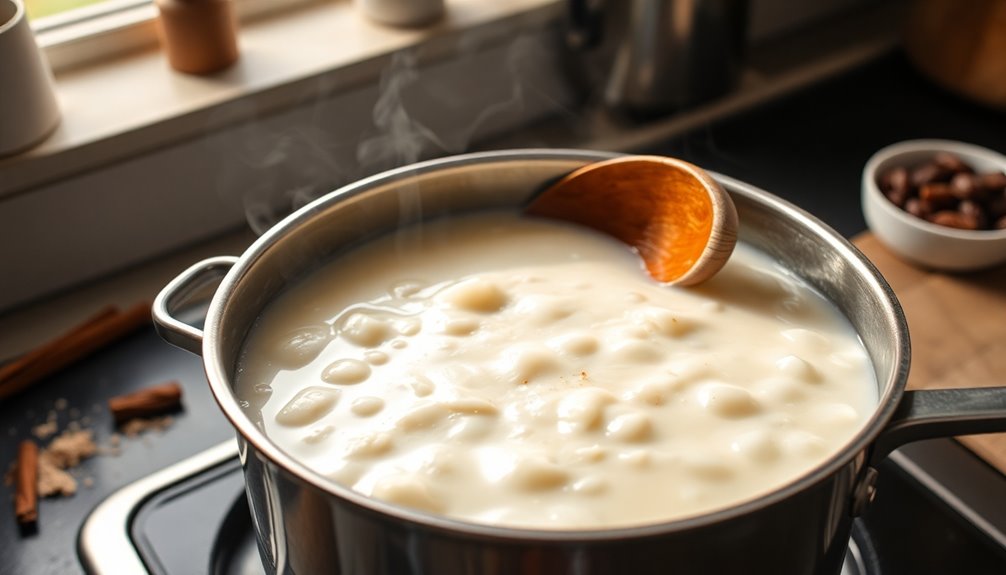
Once your mixture reaches a vigorous boil, reduce the heat and let it simmer gently. This step is crucial for making the perfect rice pudding.
As you simmer and cook, stir frequently to prevent the rice from sticking to the bottom of the pan. This will also help ensure even cooking. Allow the rice to absorb the liquid, which will thicken as it cools.
You'll want to simmer until the rice is tender and the pudding reaches a creamy consistency. For uncooked rice, this usually takes about 20-25 minutes, while cooked rice requires just 5-10 minutes.
If you desire extra thickness, you can stir in a beaten egg or a splash of milk towards the end for added richness.
Step 4. Stir in Vanilla Extract
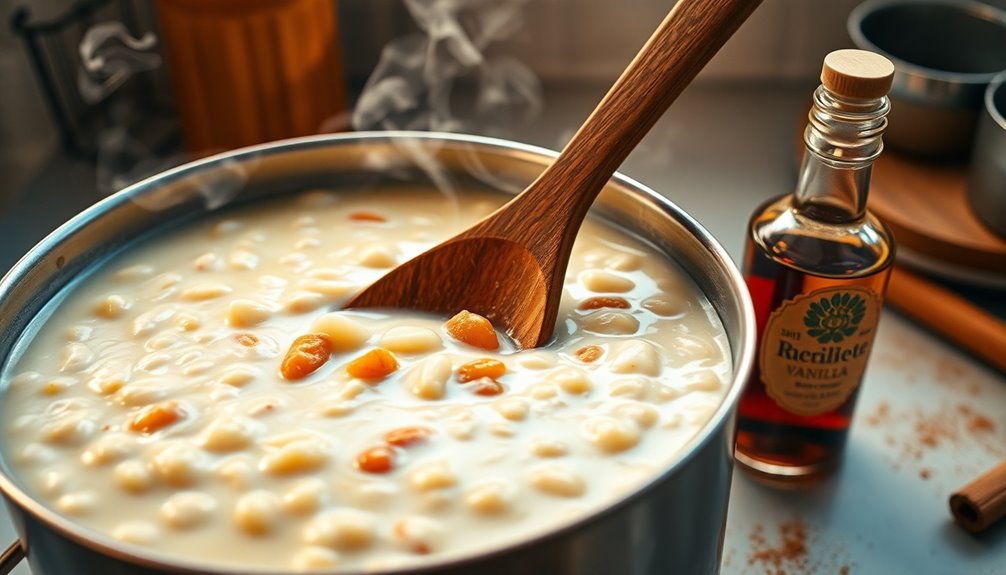
With the rice pudding nicely thickened, it's time to elevate its flavor by stirring in vanilla extract.
Remove the pudding from the heat to ensure the delicate aroma of the vanilla doesn't dissipate during cooking. Use about 1/2 to 1 teaspoon of vanilla extract, adjusting according to your preference for sweetness and intensity.
This addition will bring a sweet and aromatic touch that perfectly complements the creamy base of your rice pudding.
If you want an even richer flavor, consider using vanilla bean paste or the seeds from a vanilla bean instead of the standard extract.
Stir it in gently, and enjoy the delightful transformation this simple step brings to your dish!
Step 5. Add Sweetener to Taste
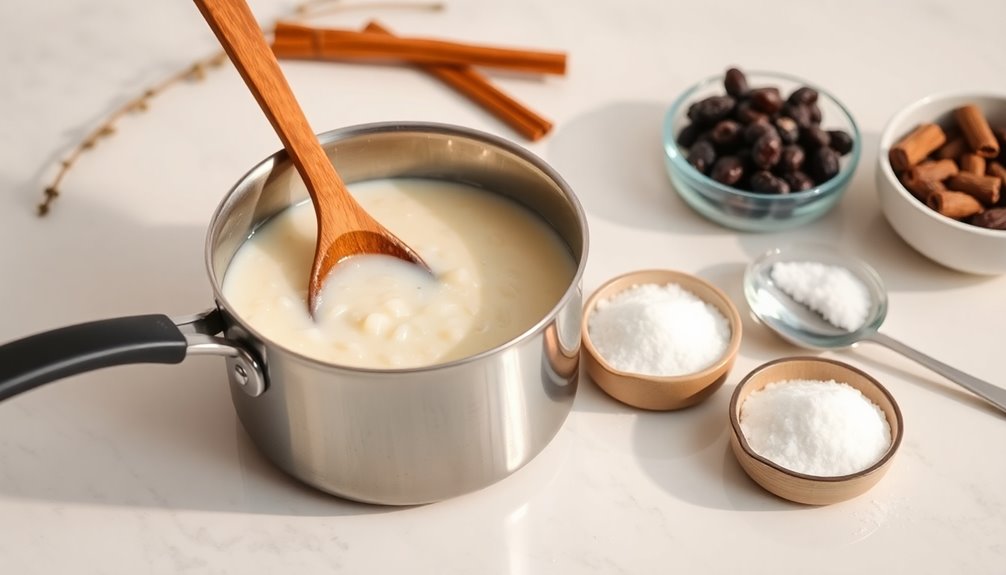
To enhance the flavor of your rice pudding, add sweetener to taste after the rice has cooked for about 20-25 minutes.
Start with 1/4 cup of granulated sugar and stir it in, allowing the sweetened milk to blend well. Everyone's sweetness preference is different, so feel free to adjust accordingly.
If you're looking for a more complex flavor, consider using honey or maple syrup, adding them gradually until you reach your desired sweetness.
Always taste the pudding before serving, as it may seem less sweet when warm but can taste sweeter once cooled.
Keep in mind that additional ingredients like raisins or spices can also add to the overall sweetness, so adjust your sugar as needed.
Final Thoughts

While you might find countless variations of rice pudding around the world, what truly makes this dessert special is its ability to adapt to your tastes and preferences.
Whether you enjoy it warm or chilled, rice pudding can be tailored to create a comforting treat that suits any occasion. You can adjust the texture and sweetness by playing with the rice-to-milk ratio and sugar levels, making it uniquely yours.
Don't forget to add a splash of vanilla or a sprinkle of cinnamon for extra warmth and flavor. Feel free to mix in raisins or dried fruits, too, for added texture.
Ultimately, rice pudding is a delightful canvas for your creativity, inviting you to explore flavors and ingredients that resonate with you.










